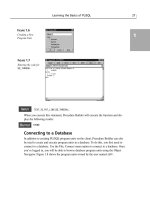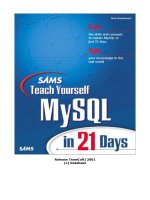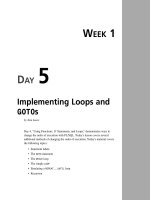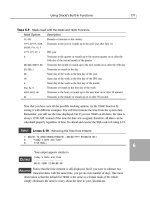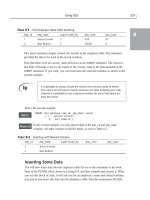Teach Yourself PL/SQL in 21 Days- P1
Bạn đang xem bản rút gọn của tài liệu. Xem và tải ngay bản đầy đủ của tài liệu tại đây (2.25 MB, 50 trang )
A Division of Macmillan USA
800 Easty 96th St.,Indianapolis,Indiana,46240 USA
PL/SQL
in
21
Days
Teach Yourself
SECOND EDITION
00 7982 fm 11/30/99 1:24 PM Page i
Please purchase PDF Split-Merge on www.verypdf.com to remove this watermark.
Sams Teach Yourself PL/SQL in
21 Days, Second Edition
Copyright ©2000 by Sams Publishing
All rights reserved. No part of this book shall be reproduced, stored in a
retrieval system, or transmitted by any means, electronic, mechanical, photo-
copying, recording, or otherwise, without written permission from the publish-
er. No patent liability is assumed with respect to the use of the information
contained herein. Although every precaution has been taken in the preparation
of this book, the publisher and author assume no responsibility for errors or
omissions. Neither is any liability assumed for damages resulting from the use
of the information contained herein.
International Standard Book Number: 0-672-31798-2
Library of Congress Catalog Card Number: 99-65434
Printed in the United States of America
First Printing: December 1999
06 05 04 03 7 6 5 4
Trademarks
All terms mentioned in this book that are known to be trademarks or service
marks have been appropriately capitalized. Sams Publishing cannot attest to
the accuracy of this information. Use of a term in this book should not be
regarded as affecting the validity of any trademark or service mark.
PL/SQL is a trademark of Oracle Corporation.
Warning and Disclaimer
Every effort has been made to make this book as complete and as accurate as
possible, but no warranty or fitness is implied. The information provided is on
an “as is” basis. The authors and the publisher shall have neither liability nor
responsibility to any person or entity with respect to any loss or damages
arising from the information contained in this book.
A
SSOCIATE
P
UBLISHER
Bradley L. Jones
A
CQUISITIONS
E
DITOR
Chris Webb
D
EVELOPMENT
E
DITOR
Steve Rowe
M
ANAGING
E
DITOR
Lisa Wilson
P
ROJECT
E
DITOR
Heather Talbot
C
OPY
E
DITOR
Kitty Jarrett
I
NDEXER
Chris Wilcox
P
ROOFREADER
Megan Wade
T
ECHNICAL
E
DITOR
Jeff Shockley
T
EAM
C
OORDINATOR
Meggo Barthlow
M
EDIA
D
EVELOPER
Dave Carson
I
NTERIOR
D
ESIGN
Gary Adair
C
OVER
D
ESIGN
Aren Howell
C
OPY
W
RITER
Eric Borgert
P
RODUCTION
Cyndi Davis-Hubler
00 7982 fm 2/25/03 10:48 AM Page ii
Please purchase PDF Split-Merge on www.verypdf.com to remove this watermark.
Contents at a Glance
Introduction 1
W
EEK
1 At a Glance 5
Day 1 Learning the Basics of PL/SQL 7
2Writing Declarations and Blocks 33
3Writing PL/SQL Expressions 63
4Using Functions,
IF
Statements, and Loops 99
5Implementing Loops and
GOTO
s 127
6Using Oracle’s Built-In Functions 155
7Procedures, Packages, Errors, and Exceptions 189
W
EEK
1 In Review 217
W
EEK
2 At a Glance 219
8Using SQL 221
9 Manipulating Data with Cursors 245
10 Collections 265
11 Writing Database Triggers 293
12 Using Oracle8i Objects for Object-Oriented Programming 333
13 Debugging Your Code and Preventing Errors 371
14 Leveraging Large Object Types 401
W
EEK
2 In Review 433
W
EEK
3 At a Glance 435
15 Managing Transactions and Locks 437
16 Generating Dynamic SQL 451
17 Writing to Files and the Display 483
18 Managing Database Jobs 509
19 Alerting and Communicating with Other Procedures: The
DBMS_ALERT
and
DBMS_PIPE
Packages 531
20 PL/SQL and Java 559
21 Advanced Queuing 585
00 7982 fm 11/30/99 1:24 PM Page iii
Please purchase PDF Split-Merge on www.verypdf.com to remove this watermark.
W
EEK
3 In Review 613
A Answers 615
Index 659
00 7982 fm 11/30/99 1:24 PM Page iv
Please purchase PDF Split-Merge on www.verypdf.com to remove this watermark.
Contents
Introduction 1
W
EEK
1 At a Glance 5
D
AY
1 Learning the Basics of PL/SQL 7
What Is PL/SQL? ....................................................................................................8
Why Learn PL/SQL? ..............................................................................................9
SQL, SQL*Plus, PL/SQL: What’s the Difference? ................................................9
SQL ....................................................................................................................9
PL/SQL ............................................................................................................10
SQL*Plus..........................................................................................................10
What You Need to Finish This Book................................................................12
Getting Started with PL/SQL ................................................................................13
PL/SQL Is Block Structured ............................................................................13
Compiling and Executing a Simple Block ......................................................15
What About Some Output? ..............................................................................17
Alternatives to Retyping ..................................................................................18
Writing Your First Function ............................................................................20
Finding Compilation Errors..............................................................................21
Displaying the Function’s Return Value ..........................................................23
Can Even This Simple Function Be Useful? ..................................................23
Executing PL/SQL Using Developer 2000’s Procedure Builder ..........................24
Starting Procedure Builder ..............................................................................24
Creating the
SS_THRESH
Function ....................................................................26
Connecting to a Database ................................................................................27
Using SQLPlus Worksheet ....................................................................................28
Executing a PL/SQL Block Using SQLPlus Worksheet..................................28
Summary................................................................................................................29
Q&A ......................................................................................................................30
Workshop ..............................................................................................................30
Quiz ..................................................................................................................31
Exercises ..........................................................................................................31
D
AY
2 Writing Declarations and Blocks 33
Exploring Datatypes ..............................................................................................34
VARCHAR2
..........................................................................................................35
CHAR
..................................................................................................................36
NUMBER
..............................................................................................................38
BINARY_INTEGER
................................................................................................41
00 7982 fm 11/30/99 1:24 PM Page v
Please purchase PDF Split-Merge on www.verypdf.com to remove this watermark.
PLS_INTEGER
......................................................................................................43
DATE
..................................................................................................................44
BOOLEAN
............................................................................................................45
LONG
..................................................................................................................46
RAW
....................................................................................................................46
LONG RAW
..........................................................................................................47
ROWID
................................................................................................................47
UROWID
..............................................................................................................48
MSLABEL
............................................................................................................48
Using Block Structure............................................................................................49
Anonymous Blocks ..........................................................................................49
Function and Procedure Blocks........................................................................51
Trigger Blocks ..................................................................................................53
Nested Blocks ..................................................................................................54
Nesting Functions and Procedures ..................................................................55
Scope Rules ......................................................................................................58
Summary................................................................................................................59
Q&A ......................................................................................................................60
Workshop ..............................................................................................................60
Quiz ..................................................................................................................60
Exercises ..........................................................................................................61
D
AY
3 Writing PL/SQL Expressions 63
Understanding Operators, Expressions, and Conversions ....................................64
Building Expressions with PL/SQL Operators......................................................64
Arithmetic Operators ........................................................................................65
Comparison Operators......................................................................................68
Logical Operators ............................................................................................76
String Operators................................................................................................78
Using Comparison Operators with Strings............................................................79
The Effect of Character Set on String Comparisons........................................79
The Datatype’s Effect on String Comparisons ................................................79
The Effect of Case on String Comparisons......................................................81
Use of Comparison Operators with Dates ............................................................82
Exploring Expressions ..........................................................................................83
Expressions Defined ........................................................................................83
Operator Precedence ........................................................................................84
Types of Expressions........................................................................................86
Null Values in Expressions ..............................................................................86
Converting Datatypes ............................................................................................92
Implicit Conversion ..........................................................................................92
Explicit Conversion ..........................................................................................94
vi Sams Teach Yourself PL/SQL in 21 Days, Second Edition
00 7982 fm 11/30/99 1:24 PM Page vi
Please purchase PDF Split-Merge on www.verypdf.com to remove this watermark.
Summary................................................................................................................95
Q&A ......................................................................................................................95
Workshop ..............................................................................................................97
Quiz ..................................................................................................................97
Exercise ............................................................................................................97
D
AY
4 Using Functions,
IF
Statements, and Loops 99
Exploring PL/SQL Functions ..............................................................................100
Defining Parameters: Formal and Actual ......................................................102
Return Types ..................................................................................................105
Function Violations ........................................................................................105
Exception Handling ........................................................................................106
Creating a Stored Function ............................................................................106
Finding Errors ................................................................................................108
The
NULL
Statement..............................................................................................110
Why Use the
NULL
Statement? ......................................................................110
How to Call a Function from PL/SQL with or Without Parameters..............110
Invoker and Definer Rights ............................................................................111
Using PL/SQL Statements ..................................................................................111
The
IF
Statement ............................................................................................112
The
IF...THEN...ELSE
Statement..................................................................113
Nested IF Statements......................................................................................114
Using
IF...ELSIF
..........................................................................................117
Nested
IF
Versus
ELSIF
..................................................................................118
Formatting
IF
Statements ..............................................................................118
Avoiding Common Mistakes When Using
IF
................................................119
Looping Statements ........................................................................................120
Reversing the Loop ........................................................................................122
Incrementing Through a Loop Differently ....................................................122
Summary..............................................................................................................123
Q&A ....................................................................................................................124
Workshop ............................................................................................................125
Quiz ................................................................................................................125
Exercises ........................................................................................................125
D
AY
5 Implementing Loops and
GOTOs
127
Exploring Labels and the
GOTO
Statement ..........................................................128
Statement Labels ............................................................................................128
The
GOTO
Statement ........................................................................................128
Scoping Rules for the
GOTO
Statement ..........................................................129
An Example of the
GOTO
Statement in Action ................................................133
Why Use the
GOTO
Statement?........................................................................133
Contents vii
00 7982 fm 11/30/99 1:24 PM Page vii
Please purchase PDF Split-Merge on www.verypdf.com to remove this watermark.
WHILE
Loops ........................................................................................................134
Examples of
WHILE
Loops ..............................................................................134
The
EXIT
and
EXIT WHEN
Statements ..................................................................138
Examples Using
EXIT
and
EXIT WHEN
............................................................139
Using Labels and
EXIT
Statements with Loops ............................................142
Simple
LOOP
s ........................................................................................................143
Sample Simple
LOOP
s......................................................................................144
Creating a
REPEAT...UNTIL
Loop ..................................................................144
An Example of a Simulated
REPEAT...UNTIL
Loop ......................................145
What Loop Should I Use? ..................................................................................146
Loop Guidelines ..................................................................................................146
Style Tips for Loops ......................................................................................148
Recursion ............................................................................................................149
Guidelines ......................................................................................................149
Practicing Recursion ......................................................................................150
Why Use Recursion? ......................................................................................152
Summary..............................................................................................................152
Q&A ....................................................................................................................153
Workshop ............................................................................................................153
Quiz ................................................................................................................153
Exercises ........................................................................................................154
D
AY
6 Using Oracle’s Built-In Functions 155
Comparing SQL Functions and PL/SQL Functions............................................156
The Major Categories of Functions ....................................................................156
Experimenting with Functions ............................................................................161
Using Conversion Functions................................................................................161
Using
TO_DATE
................................................................................................161
Using
TO_CHAR
for Dates ................................................................................166
Using
TO_NUMBER
............................................................................................168
Using
TO_CHAR
for Numbers..........................................................................174
DATE
Functions ....................................................................................................175
SYSDATE
..........................................................................................................175
The
TRUNC
Function ........................................................................................176
The
ADD_MONTHS
Function ..............................................................................178
The
NEXT_DAY
Function ..................................................................................179
The
LAST_DAY
Function ..................................................................................181
The
MONTHS_BETWEEN
Function ......................................................................182
The
NEW_TIME
Function ..................................................................................183
The
ROUND
Function ........................................................................................184
The
TRIM
Function ..........................................................................................185
viii Sams Teach Yourself PL/SQL in 21 Days, Second Edition
00 7982 fm 11/30/99 1:24 PM Page viii
Please purchase PDF Split-Merge on www.verypdf.com to remove this watermark.
Summary..............................................................................................................185
Q&A ....................................................................................................................186
Workshop ............................................................................................................186
Quiz ................................................................................................................186
Exercises ........................................................................................................187
D
AY
7 Procedures, Packages, Errors, and Exceptions 189
Using Procedures ................................................................................................190
Why Use Procedures? ....................................................................................190
Procedures Versus Functions ..........................................................................190
Creating Procedures........................................................................................190
The
RETURN
Statement ....................................................................................192
Procedure Dependencies ................................................................................192
Recompiling Stored Procedures ....................................................................193
Re-creating and Modifying Procedures..........................................................194
Invoking Stored Procedures............................................................................194
Using Parameters............................................................................................195
Parameter Definitions ....................................................................................195
Listing Stored Procedure Information............................................................195
Dropping a Stored Procedure ........................................................................197
Overloading Procedures ................................................................................197
Using Recursive Procedures ..........................................................................197
Procedure Invocation Security ............................................................................198
Exploring Packages..............................................................................................199
Why Use Packages? ......................................................................................199
The Package Specification ............................................................................200
The Package Body..........................................................................................201
Creating Packages ..........................................................................................202
Calling Package Subprograms........................................................................203
Recompiling Packages....................................................................................204
Private Versus Public Package Objects ..........................................................205
Package Invocation Security ..........................................................................205
Variables, Cursors, and Constant Persistence ................................................205
Package States ................................................................................................205
Package Dependency......................................................................................206
Trapping Errors and Exceptions ..........................................................................206
Exception-Handling Structures ......................................................................207
SQLCODE
and
SQLERRM
......................................................................................211
Continuing Processing After an Exception ....................................................212
Retrying After an Exception ..........................................................................213
Re-raising Exceptions ....................................................................................213
Exception Scope Rules ..................................................................................214
Propagating Exceptions ..................................................................................214
Contents ix
00 7982 fm 11/30/99 1:24 PM Page ix
Please purchase PDF Split-Merge on www.verypdf.com to remove this watermark.
Summary..............................................................................................................215
Q&A ....................................................................................................................215
Workshop ............................................................................................................215
Quiz ................................................................................................................215
Exercises ........................................................................................................216
W
EEK
1 In Review
217
W
EEK
2
At a Glance 219
D
AY
8 Using SQL 221
Types of SQL DML Statements ..........................................................................223
Creating Some Oracle Tables ..............................................................................223
Using the
INSERT
Statement ................................................................................226
Inserting Some Data ......................................................................................227
Singleton
SELECT
Statement ................................................................................229
Some
SELECT
Command Examples ................................................................229
Exploring the
UPDATE
and
DELETE
Statements ....................................................230
Handling Types of Exceptions ............................................................................232
Using the
LOCK TABLE
Statement ........................................................................233
Transaction Control Statements ..........................................................................234
Using Records......................................................................................................234
Declaring a Record Variable ..........................................................................234
Using the
%TYPE
Attribute ..............................................................................235
Using Record Variables Based on Database Tables ......................................236
Using Record Variables and
SELECT
Statements ............................................237
Using Record Variables Based on Cursor Definitions ..................................239
Declarations at the Package Level..................................................................240
Pseudocolumns ....................................................................................................241
CURRVAL
and
NEXTVAL
Pseudocolumns............................................................241
ROWID
Pseudocolumns ....................................................................................242
ROWNUM
Pseudocolumns ..................................................................................242
Summary..............................................................................................................242
Q&A ....................................................................................................................243
Workshop ............................................................................................................243
Quiz ................................................................................................................243
Exercises ........................................................................................................243
D
AY
9 Manipulating Data with Cursors 245
What Is a Cursor? ................................................................................................245
Explicit Cursors ..................................................................................................246
Declaring a Cursor..........................................................................................246
Declaring Cursor Parameters..........................................................................248
x Sams Teach Yourself PL/SQL in 21 Days, Second Edition
00 7982 fm 11/30/99 1:24 PM Page x
Please purchase PDF Split-Merge on www.verypdf.com to remove this watermark.
Opening the Cursor ........................................................................................248
Fetching Data in a Cursor ..............................................................................250
Closing the Cursor..........................................................................................251
Explicit Cursor Attributes ..............................................................................251
Explicit Cursor Example......................................................................................253
Automated Explicit Cursors ..........................................................................253
Implicit Cursors ..................................................................................................254
Implicit Cursor Attributes ..............................................................................254
Scope of Cursor Parameters ................................................................................256
Cursor Return Clause and Packages....................................................................256
Cursor Variables ..................................................................................................257
The Cursor Variable Declaration ....................................................................257
Cursor Usage with Cursor Variables ..............................................................258
Cursor Variable Assignments..........................................................................260
Cursor Variables as Arguments ......................................................................260
The Current Row of Cursors ..............................................................................261
Cursor Scoping ....................................................................................................262
Cursor Alias ........................................................................................................263
Summary..............................................................................................................263
Q&A ....................................................................................................................263
Workshop ............................................................................................................264
Quiz ................................................................................................................264
Exercise ..........................................................................................................264
D
AY
10 Collections 265
Using PL/SQL Index-by Tables ..........................................................................266
Declaring an Index-by Table ..........................................................................266
Inserting Entries into an Index-by Table ........................................................267
Referencing Values in an Index-by Table ......................................................268
Changing Table Entries ..................................................................................270
Deleting Table Entries ....................................................................................270
PL/SQL Table Methods ..................................................................................271
Using Nested Tables ............................................................................................274
Declaring a Nested Table................................................................................275
Adding Entries to a Nested Table ..................................................................275
Removing Entries from a Nested Table ........................................................279
Using Variable-Sized Arrays................................................................................281
Declaring and Initializing a Varray ................................................................282
Adding and Removing Data from a Varray....................................................283
Taking Advantage of Bulk Binding ....................................................................284
Using
BULK COLLECT
......................................................................................285
Using
FORALL
..................................................................................................286
Contents xi
00 7982 fm 11/30/99 1:24 PM Page xi
Please purchase PDF Split-Merge on www.verypdf.com to remove this watermark.
Exception Handling for Collections ....................................................................288
Summary..............................................................................................................289
Q&A ....................................................................................................................289
Workshop ............................................................................................................290
Quiz ................................................................................................................290
Exercise ..........................................................................................................291
D
AY
11 Writing Database Triggers 293
What Is a Trigger? ..............................................................................................294
DML Triggers ......................................................................................................294
An Example of a DML Trigger......................................................................295
Types of DML Triggers..................................................................................296
The Syntax for Defining a Database Trigger ................................................298
Uses for Triggers..................................................................................................300
Maintaining Data Integrity ............................................................................300
Maintaining History........................................................................................304
Managing Triggers ..............................................................................................307
Listing Triggers ..............................................................................................308
Viewing Trigger Code ....................................................................................309
Enabling and Disabling Triggers....................................................................310
Nontraditional Triggers........................................................................................311
The Syntax for Defining a Trigger on a Database or Schema Event ............312
Event Attributes ..............................................................................................313
Writing a Trigger for a Database Event ........................................................314
Writing a Trigger for a DDL Event................................................................316
Using Instead-of Triggers ....................................................................................318
The Syntax for Defining an Instead-of Trigger..............................................318
Writing an Instead-of Trigger ........................................................................319
Exploring Trigger Limitations ............................................................................320
Triggers and Mutating Tables ........................................................................320
Summary..............................................................................................................329
Q&A ....................................................................................................................329
Workshop ............................................................................................................330
Quiz ................................................................................................................330
Exercises ........................................................................................................331
D
AY
12 Using Oracle8i Objects for Object-Oriented Programming 333
A Brief Primer on Object-Oriented Programming ..............................................334
Encapsulation..................................................................................................334
Inheritance ......................................................................................................335
Polymorphism ................................................................................................335
Classes, Objects, Attributes, and Methods ....................................................336
Advantages of OOP Over Traditional Methods ............................................336
xii Sams Teach Yourself PL/SQL in 21 Days, Second Edition
00 7982 fm 11/30/99 1:24 PM Page xii
Please purchase PDF Split-Merge on www.verypdf.com to remove this watermark.
Contents xiii
How Oracle8i Implements Objects......................................................................337
Object Types ..................................................................................................337
Object Tables ..................................................................................................337
Object Views ..................................................................................................337
Defining an Object Type......................................................................................337
Constructor Methods ......................................................................................341
Accessor Methods ..........................................................................................342
Mutator Methods ............................................................................................342
Instantiating and Using Objects ..........................................................................343
Storing and Retrieving Objects............................................................................345
Storing Objects as Table Columns ................................................................345
Retrieving and Updating Objects in a Table Column ....................................347
Using Object Tables ............................................................................................349
Storing Objects in an Object Table ................................................................351
Retrieving and Updating Objects in an Object Table ....................................352
Deleting Objects from an Object Table..........................................................356
Nesting and Sharing Objects ..............................................................................356
Dot Notation ..................................................................................................356
Object References ..........................................................................................358
Exploring the
SELF
Parameter..............................................................................361
Overloading..........................................................................................................363
Comparing Objects ..............................................................................................363
The
ORDER
Method..........................................................................................364
The
MAP
Method..............................................................................................366
Limitations of Oracle’s Implementation..............................................................367
Summary..............................................................................................................367
Q&A ....................................................................................................................368
Workshop ............................................................................................................369
Quiz ................................................................................................................369
Exercises ........................................................................................................369
D
AY
13 Debugging Your Code and Preventing Errors 371
Locating and Eliminating Syntax Errors ............................................................372
Identifying Syntax Errors ..............................................................................372
An Example of Identifying Syntax Errors ....................................................373
Preventing Syntax Errors................................................................................377
Handling Logic Errors ........................................................................................378
Order of Operations........................................................................................379
Nonterminating Loops....................................................................................380
Debugging Approaches for Logic Errors ......................................................380
Using Tools to Help in Debugging a Program ....................................................384
Using
DBMS_OUTPUT
as a Debugging Tool ......................................................385
Writing a
DEBUG
Package ................................................................................385
00 7982 fm 11/30/99 1:24 PM Page xiii
Please purchase PDF Split-Merge on www.verypdf.com to remove this watermark.
xiv Sams Teach Yourself PL/SQL in 21 Days, Second Edition
Preventing Errors and Planning for Debugging in the Future ............................391
Defining Requirements and Planning Projects ..............................................391
Using a Modular Approach to Coding ..........................................................392
Commenting Code..........................................................................................392
Writing Assertions into Code ........................................................................394
Formatting Code ............................................................................................395
Summary..............................................................................................................398
Q&A ....................................................................................................................398
Workshop ............................................................................................................399
Quiz ................................................................................................................399
Exercises ........................................................................................................400
D
AY
14 Leveraging Large Object Types 401
Exploring Large Object Datatypes ......................................................................402
Limitations of
LOB
s ........................................................................................402
LOB
Versus
LONG
Datatypes ............................................................................403
Converting
LONG
s to
LOB
s ..............................................................................404
Using External Files in an Oracle8i Database ....................................................404
Creating the Directory Object ........................................................................404
Limitations of
BFILE
......................................................................................405
Using the
DBMS_LOB
Package with
BFILE
............................................................406
The
BFILENAME
Function ................................................................................406
The
COMPARE
Function ....................................................................................407
The
FILECLOSE
Procedure..............................................................................408
The
FILECLOSEALL
Procedure ........................................................................408
The
FILEEXISTS
Function ..............................................................................408
The
FILEGETNAME
Procedure ..........................................................................409
The
FILEISOPEN
Function ..............................................................................409
The
FILEOPEN
Procedure ................................................................................410
The
GETLENGTH
Function ................................................................................410
The
INSTR
Function ........................................................................................410
The
READ
Procedure ........................................................................................411
The
SUBSTR
Function ......................................................................................411
Exploring
BFILE
Examples, Using the
DBMS_LOB
Package ..................................412
Accessing
BFILE
s............................................................................................412
Comparing Files ............................................................................................414
Working with Locators ........................................................................................416
Using the
DBMS_LOB
Package with Internal
LOB
s ................................................416
The
APPEND
Procedure ....................................................................................417
The
COMPARE
Function ....................................................................................417
The
COPY
Procedure ........................................................................................418
The
EMPTY_BLOB
Function ..............................................................................419
The
EMPTY_CLOB
Function ..............................................................................419
The
ERASE
Procedure ......................................................................................419
00 7982 fm 11/30/99 1:24 PM Page xiv
Please purchase PDF Split-Merge on www.verypdf.com to remove this watermark.
Contents xv
The
GETLENGTH
Function ................................................................................420
The
INSTR
Function ........................................................................................420
The
READ
Procedure ........................................................................................421
The
SUBSTR
Function ......................................................................................421
The
TRIM
Procedure ........................................................................................422
The
WRITE
Procedure ......................................................................................422
Exploring Internal
LOB
Examples, Using the
DBMS_LOB
Package ........................423
Creating a Table..............................................................................................423
Adding Data to the Table................................................................................423
Populating the
LOBS
Table with the
COPY
Procedure ......................................424
Manipulating Internal
LOB
s by Using
APPEND
and
WRITE
..............................425
Analyzing the Contents of an Internal
LOB
....................................................427
Using
TRIM
and
ERASE
to Edit
CLOB
s ..............................................................428
Temporary
LOB
s....................................................................................................430
Managing Temporary
LOB
s ............................................................................430
Creating Temporary
LOB
s................................................................................430
Summary..............................................................................................................431
Q&A ....................................................................................................................431
Workshop ............................................................................................................432
Quiz ................................................................................................................432
Exercise ..........................................................................................................432
W
EEK
2 In Review
433
W
EEK
3
At a Glance 435
D
AY
15 Managing Transactions and Locks 437
Types of Transactions ..........................................................................................438
Starting a Transaction ..........................................................................................438
Ending a Transaction ..........................................................................................439
Canceling a Transaction ......................................................................................441
Exploring the Two-Phase Commit ......................................................................441
Creating Bookmarks with Savepoints ................................................................442
Using Release Option ..........................................................................................443
Using Locking......................................................................................................443
Locking Tables ..............................................................................................443
Locking Rows ................................................................................................445
Explicit Locks ................................................................................................445
The
DBMS_LOCK
Package..................................................................................446
Using Other Locks..........................................................................................449
Monitoring Locks ..........................................................................................449
00 7982 fm 11/30/99 1:24 PM Page xv
Please purchase PDF Split-Merge on www.verypdf.com to remove this watermark.
Summary..............................................................................................................450
Q&A ....................................................................................................................450
Workshop ............................................................................................................450
Quiz ................................................................................................................450
Exercise ..........................................................................................................450
D
AY
16 Generating Dynamic SQL 451
What Is Dynamic SQL and Why Use It? ............................................................452
Two Approaches to Dynamic SQL ......................................................................452
Using the
DBMS_SQL
Package................................................................................453
Using the
DBMS_SQL
Package with Non-Query DDL and DML
Statements....................................................................................................454
Using the
DBMS_SQL
Package with Queries ....................................................460
Using the
DBMS_SQL
Package with Anonymous PL/SQL Blocks ..................467
DBMS_SQL
Error Handling................................................................................471
Using
LAST_ROW_COUNT
..................................................................................471
Using
LAST_ROW_ID
........................................................................................471
Using
LAST_ERROR_POSITION
..........................................................................474
Using Native Dynamic SQL................................................................................474
Executing DML and DDL..............................................................................474
Executing SQL Queries..................................................................................476
Executing PL/SQL Blocks ............................................................................479
Summary..............................................................................................................480
Q&A ....................................................................................................................480
Workshop ............................................................................................................481
Quiz ................................................................................................................481
Exercise ..........................................................................................................481
D
AY
17 Writing to Files and the Display 483
Exploring the
DBMS_OUTPUT
Package ..................................................................484
Enabling the
DBMS_OUTPUT
Package................................................................484
Disabling the
DBMS_OUTPUT
Package ..............................................................485
Writing Data to the Buffer ............................................................................486
Reading Data from the Buffer........................................................................487
Exceptions Raised from the
DBMS_OUTPUT
Package ......................................491
Reading and Writing Files with the
UTL_FILE
Package ......................................491
File Input ........................................................................................................492
Using
UTL_FILE
Procedures and Functions....................................................493
An Example of Using
UTL_FILE
....................................................................500
Exploring
TEXT_IO
with Client Files ..................................................................504
Summary..............................................................................................................506
Q&A ....................................................................................................................506
Workshop ............................................................................................................507
Quiz ................................................................................................................507
Exercise ..........................................................................................................507
xvi Sams Teach Yourself PL/SQL in 21 Days, Second Edition
00 7982 fm 11/30/99 1:24 PM Page xvi
Please purchase PDF Split-Merge on www.verypdf.com to remove this watermark.
D
AY
18 Managing Database Jobs 509
Submitting Jobs by Using the
DBMS_JOB
Package ..............................................510
Using Background Processes ..............................................................................510
Executing Jobs ....................................................................................................512
Submitting Jobs to the Job Queue by Using
SUBMIT
......................................512
Using
RUN
to Execute Jobs Immediately ........................................................514
Exploring the Job Environment......................................................................515
Viewing Jobs ........................................................................................................517
Samples for Viewing Jobs ..............................................................................519
Exploring Job Management ................................................................................519
Removing a Job ..............................................................................................520
Altering a Job ................................................................................................520
Importing and Exporting Jobs ........................................................................521
Handling Broken Jobs ....................................................................................521
Hands-on Practice in Job Management ..............................................................522
Creating Procedures to Submit as Jobs ..........................................................522
Submitting All Jobs to the Job Queue............................................................524
Running All Three Jobs Immediately ............................................................524
Viewing Information About the Jobs ............................................................525
Altering the Job by Running the
HELLO
Job ..................................................525
Removing the Hello Job ................................................................................526
Summary..............................................................................................................528
Q&A ....................................................................................................................528
Workshop ............................................................................................................529
Quiz ................................................................................................................529
Exercises ........................................................................................................529
D
AY
19 Alerting and Communicating with Other Procedures:
The
DBMS_ALERT
and
DBMS_PIPE
Packages 531
The
DBMS_ALERT
Package ....................................................................................532
Using
SIGNAL
to Issue an Alert ............................................................................533
Registering for an Alert ......................................................................................533
Waiting for a Specific Alert ................................................................................534
Waiting for Any Registered Alert ........................................................................535
Removing One Alert ............................................................................................535
Removing All Alerts ............................................................................................536
Polling and Events with the
SET_DEFAULTS
Procedure ........................................536
Demonstrating the
DBMS_ALERT
Package..............................................................536
Creating the Backup Database ......................................................................537
Creating the Trigger to Signal an Alert ..........................................................538
Waiting for the Alert ......................................................................................539
The
DBMS_PIPE
Package ......................................................................................543
Public Versus Private Pipes ............................................................................543
Using Pipes ....................................................................................................544
Contents xvii
00 7982 fm 11/30/99 1:24 PM Page xvii
Please purchase PDF Split-Merge on www.verypdf.com to remove this watermark.
The Functions and Procedures of
DBMS_PIPE
................................................546
An Example of Using Pipes ..........................................................................550
Other Pipe Functions and Procedures ............................................................553
Other Uses for Pipes ......................................................................................555
Alerts Versus Pipes ..............................................................................................555
Summary..............................................................................................................556
Q&A ....................................................................................................................556
Workshop ............................................................................................................557
Quiz ................................................................................................................557
Exercises ........................................................................................................558
D
AY
20 PL/SQL and Java 559
Using Oracle’s Java Engine ................................................................................560
Will PL/SQL Go Away? ......................................................................................561
Creating a Java Procedure....................................................................................561
Prerequisites Needed ......................................................................................561
The
SS_CONSTANTS
Class ................................................................................562
Loading the Class ..........................................................................................563
Publishing the
SSThresh
Method ..................................................................565
Calling
SS_THRESH
from SQL*Plus ................................................................566
Calling
SS_THRESH
from PL/SQL ..................................................................567
Dropping the
SSConstants
Class ..................................................................568
Calling Java from PL/SQL ..................................................................................569
The
Employee
Class ........................................................................................569
Publishing a Java Method ..............................................................................571
Datatype Compatibility ..................................................................................574
Using the
OUT
and
IN OUT
Arguments............................................................575
Calling PL/SQL from Java Using SQLJ..............................................................578
Using SQLJ to Execute an Anonymous PL/SQL Block................................578
Using SQLJ to Call a PL/SQL Procedure or Function ..................................579
Summary..............................................................................................................582
Q&A ....................................................................................................................583
Workshop ............................................................................................................583
Quiz ................................................................................................................584
Exercise ..........................................................................................................584
D
AY
21 Advanced Queuing 585
What Is AQ? ........................................................................................................586
Removing Some of the Mystery from AQ ....................................................586
Key Features of AQ ........................................................................................587
Configuring Your Server to Use AQ ....................................................................588
Exploring an AQ Scenario ..................................................................................590
Creating a Message Queue ..................................................................................591
xviii Sams Teach Yourself PL/SQL in 21 Days, Second Edition
00 7982 fm 11/30/99 1:24 PM Page xviii
Please purchase PDF Split-Merge on www.verypdf.com to remove this watermark.
Defining a Type for the Payload ....................................................................591
Creating the Queue Table ..............................................................................592
Creating the Queue ........................................................................................595
Starting and Stopping a Queue ............................................................................597
Placing Messages in a Queue ..............................................................................598
Enqueue-Related Record Types ....................................................................599
Enqueuing a Message ....................................................................................602
Retrieving Messages from a Queue ....................................................................604
Dequeue-Related Record Types ....................................................................604
Dequeuing a Message ....................................................................................606
Using Other AQ Procedures ..............................................................................608
Dropping a Queue ..........................................................................................608
Dropping a Queue Table ................................................................................609
Granting and Revoking Access to a Queue....................................................609
Summary..............................................................................................................610
Q&A ....................................................................................................................611
Workshop ............................................................................................................611
Quiz ................................................................................................................611
Exercises ........................................................................................................612
W
EEK
3 In Review
613
A
PPENDIX
A Answers 615
Index 659
Contents xix
00 7982 fm 11/30/99 1:24 PM Page xix
Please purchase PDF Split-Merge on www.verypdf.com to remove this watermark.
About the Authors
Jonathan Gennick is a manager in KPMG Consulting’s Public Services practice, where
he specializes in Oracle technologies. He got his start with relational database systems in
1990, first working with Ingres, and then later with Digital’s Rdb software. In 1994 he
made the leap to Oracle, and hasn’t looked back yet. Much of his time is spent providing
database administration services, as well as server-side PL/SQL support, to clients and
internal project teams.
When he is not working with Oracle, Jonathan can often be found writing about it. Since
1997 he has been involved with a number of writing projects. He coauthored the first
edition of this book, Sams Teach Yourself PL/SQL in 21 Days. He was the technical edi-
tor for Oracle8 Server Unleashed (Sams, 1998), and the development editor for Sams
Teach Yourself Access 2000 in 24 Hours (Sams, 1999). His second book, SQL*Plus, The
Definitive Guide,was published in 1999 by O’Reilly & Associates. In addition to
coauthoring the second edition of this book, Jonathan continues to be involved in various
other writing and editing projects.
Writing has given Jonathan the opportunity to pursue several interests outside his normal
day-to-day work. He is a member of the technology committee for the Greater Lansing
Adventist School, where he is currently helping to set up both a LAN and an Internet
connection. This satisfies his gnawing need to learn new things, and also his desire to
help others learn.
Jonathan is a member of MENSA, and he holds a bachelor of arts degree in information
and computer science from Andrews University in Berrien Springs, Michigan. Jonathan
resides in Lansing, Michigan, with his wife, Donna, and their two children, Jenny and
Jeff. Jonathan can be contacted by email at
.
Tom Luers, PMP, is a principle consultant with a leading international information tech-
nology consulting firm. Over the past 16 years, he has worked with clients and business
partners in Europe, North America, and Asia. Tom specializes in Project Management,
Oracle technologies, and implementing IT solutions to meet business, manufacturing,
and engineering needs. He is also the author of Sams Publishing’s Essential Oracle7.
00 7982 fm 11/30/99 1:24 PM Page xx
Please purchase PDF Split-Merge on www.verypdf.com to remove this watermark.




